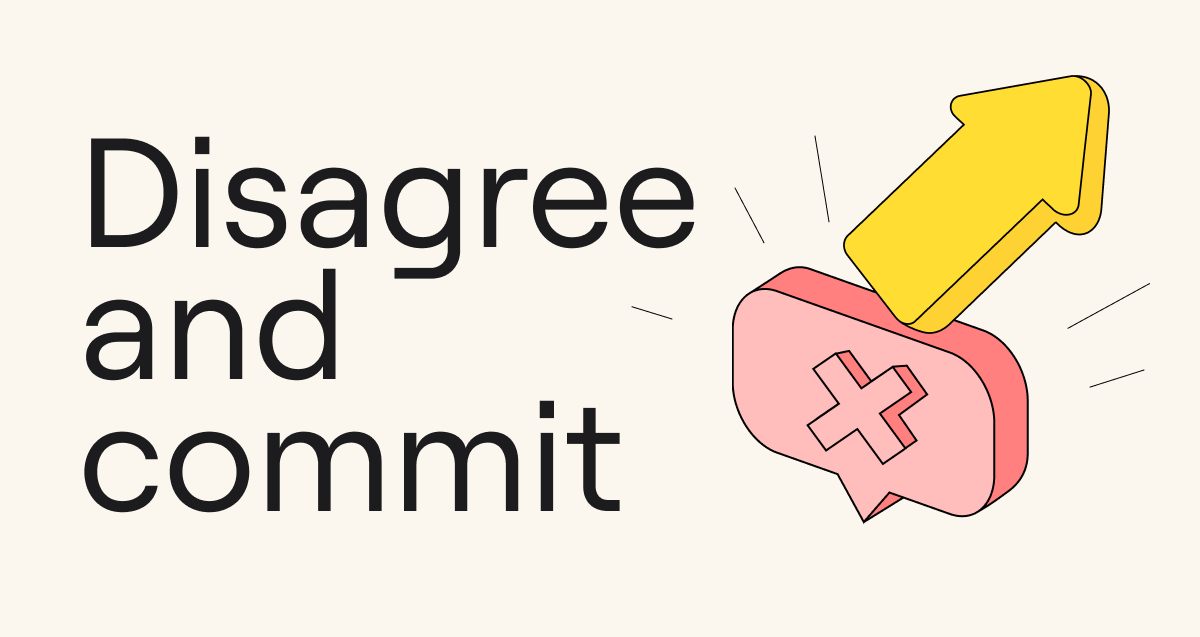Many of us know the feeling: you’ve been asked to work on a task or project that you think is unideal, but you don’t feel comfortable or empowered enough to say something about it.
So you keep quiet and carry on. You’re getting the job done, but holding some doubt or even resentment. Maybe there are some extra meetings popping up as others on your team start to poke holes in the original plan.
This is the kind of scenario that plays out far too often in the workplace. It’s a complicated issue with many potential solutions and preventions. Today we’ll look at one: “disagree and commit.”
Let’s take a look at the concept, why it’s impactful, steps to effectively disagree and commit in the workplace, and how Miro brings it all to life.
What does it mean to disagree and commit?
Disagree and commit is a style of management that’s aimed at fostering open, collaborative communication as a way to get things done quickly and efficiently.
Its function is two-fold: team members on every rung of the totem pole are given a platform to openly disagree with an upcoming plan or project. This encourages the whole team, including leadership, to talk about it freely and address everyone’s concerns.
Then, after the discussion (which may or may not change the original plan), the whole team commits to getting the job done, regardless of the final decision.
This process ultimately encourages teams to make quick decisions and implement them with full effort, even if there’s uncertainty or doubt. This is also referred to as bias for action: the tendency to make a quick decision and take action on an idea rather than keep trying to analyze, risk-manage, and ultimately delay execution.
This ties into another management style: fail fast so you can learn and grow quickly.
Open, collaborative communication is key to unlocking the enormous potential of highly diverse teams. Without it, those differences can cause each member to blindly pull in a different direction, creating frustration for themselves and their colleagues.
Why disagreement is actually a good thing
It may seem counterintuitive if you want a cooperative and harmonious work environment. When left unchecked or unstructured, disagreement can be a one-way street to tension, stress, and negative outcomes.
But while it can be a tough pill to swallow, it’s impossible for everyone to be 100% on board all the time. And if you’re part of a well-rounded and diverse multi-disciplinary team, disagreement will actually be one of your paths to greatness. Varying opinions and perspectives can unlock holistic, inclusive ideas and strategies that never would’ve happened if everyone was always on the same page.
In a global company like Miro, disagreement is inevitable. In our team, we have built trust among ourselves, enabling transparent communication that fosters diverse perspectives and creative ideas.
So instead of shunning and limiting disagreement, the most successful teams harness its power.
Cue strategies like disagree and commit. It’s a structured, methodical way to lay out disagreements and work through them together. This helps to make sure that, despite differences in attitude and opinion, everyone feels empowered to speak their mind and voice their questions and concerns.
This in turn builds more effective, collaborative, and integrated teams. On an individual level, team members feel a sense of belonging and value that contributes to being overall happier and more satisfied with their careers.
Steps to effectively disagree and commit
While the exact process will play out differently for each team, there are some basic steps that they’ll all typically follow. Let’s take a look.
1. Present
This is the proposal stage where the individual(s) who are spearheading the initiative lay it all out for everyone involved. Depending on the type and scope of the initiative, this process will vary.
For example, a large-scale project like a website redesign will likely require a more thorough presentation of ideas and explanations. On the other hand, a proposal like moving a weekly meeting to a new day and time won’t involve the same bells and whistles.
If you’re the presenter, you’re tasked with clear communication. It’s important to explain the plan, the logic and rationale behind it, how you plan to execute, the ideal outcome (and potential roadblocks), and who will be involved in each stage. This way, you’re giving your team all the key points they need to really evaluate the proposal.
2. Discuss (and disagree!)
Showtime. After the presenter has made their case, it’s time to open the floor to anyone who might have a counter-argument. This can be done in real time, for example in a team meeting, or teams can implement an ongoing “open door” policy where team members are encouraged to discuss with leadership in a more private environment.
Just keep in mind that after-the-fact conversations may require everyone to revisit the plan later, which can add some extra time to the execution process.
Here are some things to keep in mind while sharing and hearing out disagreements as a team:
- Give solutions. Instead of flat-out disagreeing, can you suggest an alternative action plan? This can guide the discussion much more smoothly.
- State your why. Be clear about why you disagree and how your counter-argument might create a better outcome.
- Keep a growth mindset. Remember: disagreement is an opportunity for learning, creativity, improvement, and innovation for everyone.
- Stop and listen. Hearing and listening are 2 different things. Are you truly listening to your teammate’s arguments with a curious and open-minded attitude?
- Trade shoes. Try to view the disagreement from the other person’s perspective so it’s easier to practice empathy and reach a compromise.
- Be respectful. Acknowledge that everyone is trying their best. Frame disagreements toward ideas and outcomes, and not towards other people.
- Put your ego aside. Try to frame disagreement as constructive and for the good of the company, instead of a criticism of anyone’s individual contributions or performance.
- Reflect internally. If you’re feeling resistance to new ideas, ask yourself why. Now’s the time to explore if and how your emotions are painting your perspective.
- Encourage authenticity. Play your part to create a “safe space” where nobody feels threatened, intimidated, or undervalued when sharing their honest opinion.
Agreeing on everything is impossible, and respectful disagreements can lead to creative brainstorming and improved ideas. Embracing differing opinions allows for the possibility of even better ideas than the ones initially envisioned.
3. Finalize and commit
Ultimately, leadership is still in charge of the final decision. The outcome may be a comfortable middle ground where everyone is satisfied, or there may be some ideas that don’t get implemented at all.
No matter the outcome, now is the time for everyone to commit 100% to doing their agreed-upon part—no more changes or discussions. Just the rubber hitting the road.
Here are some questions every team member (especially leadership) can ask to help lead everyone to an ideal decision:
- How can this project or initiative best serve the core vision and mission of the company?
- What are the potential benefits, drawbacks, costs, and risks of each idea presented?
- Are there any data points that can add some extra support to any/all of the ideas presented?
- Can we do any testing or research to validate the idea(s) before we invest fully?
- Are there any long-term impacts that could potentially derail or interfere with our intended outcome?
How Miro facilitates a smooth “disagree and commit” process
Miro is driven by a culture of collaborative growth. It’s critical that Mironeers feel like they’re truly part of a team, working together harmoniously toward a common goal. You can even see it in our 4 core company values:
- Play as a team to win the world
- Focus on impact and make it happen
- Practice empathy to gain insight
- Learn, grow, and drive change
One of the drivers of these values is an ingrained feedback culture. We’re always looking for input and new ideas from colleagues while focusing on the ability to give and receive feedback openly, honestly, and empathetically. And because these feedback interactions take place across every position and location, every Mironeer can feel like a valued piece of the puzzle.
It all starts with onboarding, where new Mironeers are given practical training on how to give and receive feedback. After the 60-day onboarding period, they’re given 360-degree feedback from leads and team members, followed by a 30-minute meeting with their managers to strategize how they’ll implement that feedback moving forward.
Our feedback culture includes positive feedback too: the Slack recognition channel lets leads and other team members give praise to every Mironeer where it’s due. And tools like the Emotion Wheel Icebreaker help to connect team members through the power of empathy (this was especially true when we developed the wheel in 2020 when the pandemic and social unrest were huge stressors for everyone).
When done right, disagreement is growth
A lot of us have been socially conditioned to equate disagreement with negative sentiments and experiences, like being angry, inappropriate, rude, or outright mean. Because we want to avoid this, we tend to bottle up our disagreements instead of sharing them.
But disagreement is inevitable. There’s just no way to avoid it. So when teams embrace collaborative, open-minded strategies like disagree and commit, it’s like championing that old saying: “If you can’t beat ‘em, join ‘em.” This helps to create better business outcomes while improving the personal experiences and even the mental health of everyone on the team.
When you’re a part of a team that truly values your opinion, even if it’s difficult, you and everyone else are in a better position to succeed, learn, and grow.









